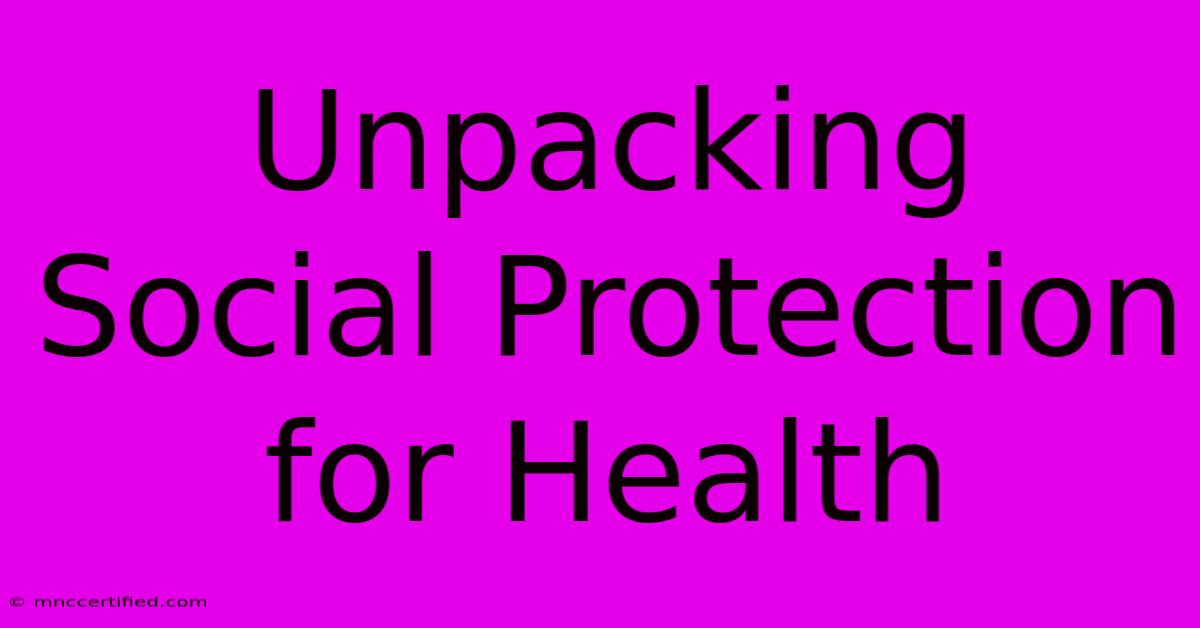Unpacking Social Protection For Health

Table of Contents
Unpacking Social Protection for Health: A Comprehensive Guide
Social protection for health is a crucial element of achieving universal health coverage (UHC) and ensuring healthier populations. It's more than just healthcare; it's a multifaceted system designed to safeguard individuals and families from the financial and social risks associated with ill health. This article unpacks the key components of social protection for health, its benefits, challenges, and future directions.
What is Social Protection for Health?
Social protection for health encompasses a range of policies and programs aimed at mitigating the financial and social consequences of illness. These programs act as a safety net, preventing individuals from falling into poverty due to healthcare costs or loss of income related to illness. Key elements often include:
- Health insurance: This provides financial protection against healthcare expenses, covering costs like consultations, treatments, and hospitalizations. This can range from basic schemes to comprehensive coverage.
- Cash transfers: Conditional or unconditional cash transfers can help households afford healthcare, nutritious food, and other necessities, promoting better health outcomes. Conditional cash transfers often require recipients to meet certain conditions, such as regular healthcare check-ups for children.
- Sick leave and disability benefits: These policies guarantee income security during periods of illness or disability, preventing financial hardship and encouraging timely treatment-seeking behavior.
- Social health insurance: This is a form of mandatory health insurance, often funded through contributions from employers and employees, providing a wider safety net.
Benefits of Robust Social Protection for Health
The advantages of strong social protection for health are multifaceted and extend beyond individual well-being:
- Improved health outcomes: Financial protection allows people to seek timely and appropriate healthcare, leading to better health outcomes and reduced mortality rates.
- Reduced poverty: Healthcare costs are a leading cause of poverty. Social protection minimizes this risk, safeguarding vulnerable populations.
- Increased health equity: Well-designed programs can specifically target vulnerable and marginalized groups, reducing health disparities.
- Economic growth: Healthier populations contribute more productively to the economy. Strong social protection systems contribute to a healthier and more productive workforce.
- Enhanced social cohesion: Social protection programs build trust in government and strengthen social cohesion by providing a safety net for all citizens.
Challenges in Implementing Social Protection for Health
While the benefits are substantial, implementing effective social protection systems faces significant hurdles:
- Funding: Securing sufficient and sustainable funding for comprehensive social protection programs is a major challenge, particularly in low-income countries.
- Administrative capacity: Efficient administration and management of complex programs require robust institutional capacity and skilled personnel.
- Political will: Successful implementation hinges on strong political will and commitment to prioritize health and social protection.
- Coverage gaps: Ensuring equitable coverage for all members of the population, especially marginalized groups, is crucial but often difficult to achieve.
- Sustainability: Designing sustainable programs that can adapt to changing economic and demographic conditions is critical for long-term success.
The Future of Social Protection for Health
The future of social protection for health is intricately linked with the global pursuit of Universal Health Coverage (UHC). This requires:
- Strengthening primary healthcare: Investing in primary healthcare is crucial for early detection and prevention of diseases, reducing the need for expensive secondary and tertiary care.
- Integrating social protection with health systems: Effective integration ensures seamless access to services and maximizes the impact of both.
- Innovative financing mechanisms: Exploring innovative financing approaches, such as public-private partnerships and pooled risk mechanisms, can enhance funding sustainability.
- Data-driven decision making: Utilizing robust data collection and analysis to monitor program effectiveness and make evidence-based policy adjustments.
- Community engagement: Active community participation is vital for designing and implementing culturally appropriate and effective social protection programs.
Conclusion: Investing in a Healthier Future
Social protection for health is a crucial investment in human capital and national development. By addressing the challenges and pursuing innovative solutions, countries can build more resilient and equitable health systems that deliver better health outcomes for all. A strong emphasis on inclusive policies, sustainable financing, and effective governance will be key to unlocking the full potential of social protection for health and advancing towards universal health coverage.

Thank you for visiting our website wich cover about Unpacking Social Protection For Health. We hope the information provided has been useful to you. Feel free to contact us if you have any questions or need further assistance. See you next time and dont miss to bookmark.
Featured Posts
-
Havant Mp Visits Ucl
Nov 27, 2024
-
Brightway Insurance Boca Raton
Nov 27, 2024
-
Small Business Insurance Maine
Nov 27, 2024
-
Why Barcelona Closed Stadium Section Indefinitely
Nov 27, 2024
-
Auto Insurance Tracking Device
Nov 27, 2024